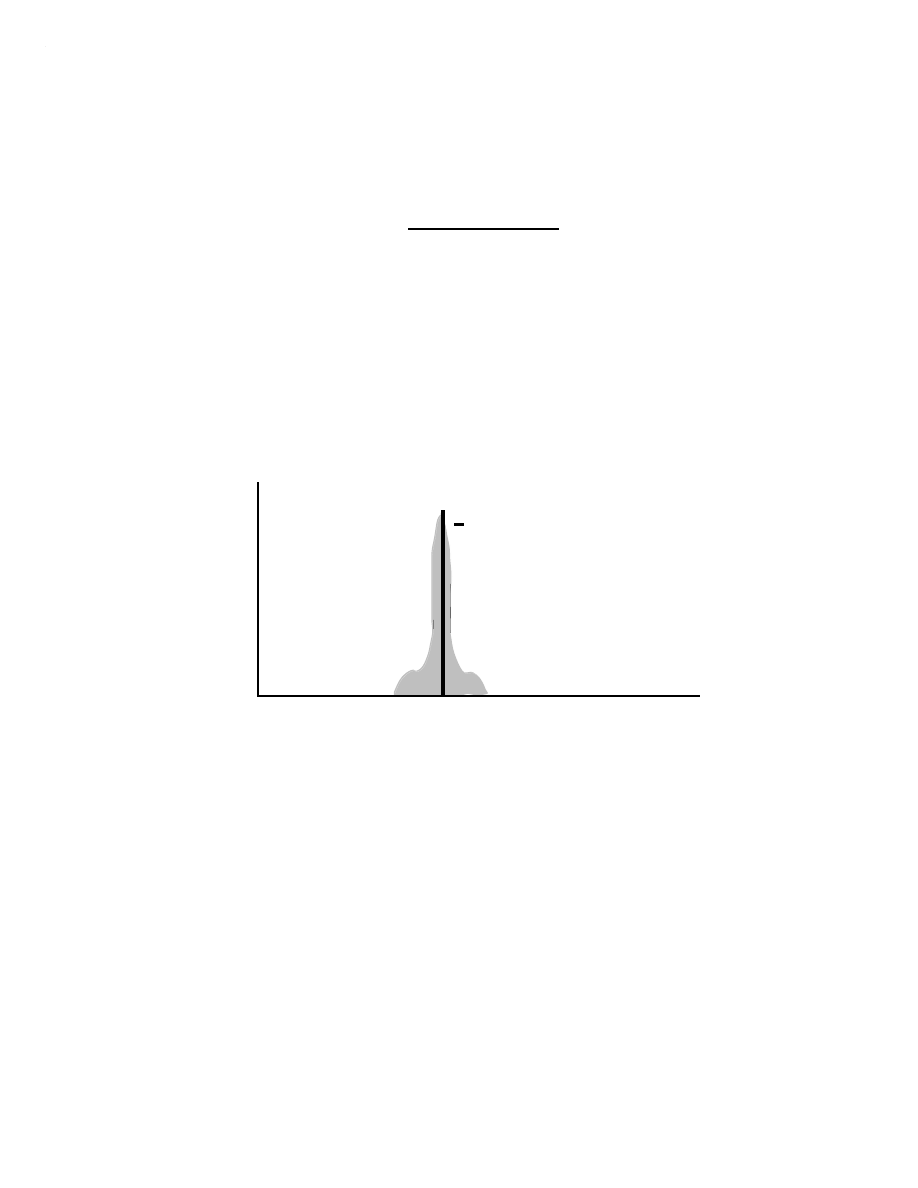ВУЗ: Казахская Национальная Академия Искусств им. Т. Жургенова
Категория: Учебное пособие
Дисциплина: Не указана
Добавлен: 03.02.2019
Просмотров: 12346
Скачиваний: 6

P
presence: The intelligibility of a track; a subjective term describing the amount of mid- to up-
per-midrange frequencies in the sound source. Boosting a track’s presence helps to bring the
track forward in the image, and is effected by increasing the amplitude of frequencies in the
range of approximately 800Hz-6kHz, typically in the more narrow band of 2kHz-4kHz.
presence peak: A characteristic of some transducers, typically dynamic microphones, whereby
the frequency response in the 5kHz range is naturally boosted, giving an edgier, punchier sound.
preset: (1) A factory-programmed synthesizer patch that cannot be altered by the user. (2)
Any patch. Some synthesizer manufacturers make distinctions between presets, programs,
and/or patches, each of which contains a different set of parameters.
pressure: See aftertouch.
pressure gradient: A type of microphone construction which supports the transducer diaphragm
on the top and bottom, leaving it open to the air on both sides. This produces a figure-eight re-
sponse pattern. Mics of this type are more complex and delicate than pressure operation-type
mics, and have many more mechanical and physical problems such as extreme susceptibility
to handling noise, rumble, sensitivity to wind, and proximity effect. In addition, the diaphragm
assembly has to compensate for the inadequacies of the pressure gradient by making the dia-
phragm resonate at very low frequencies, generally restricting the smoothness and extension
of the very lowest part of the audio spectrum. These disadvantages are, however, overlooked
because of the directivity of these microphones. Cardioid microphones are a combination of pres-
sure gradient and pressure operation transduction within a single unit.
pressure operation: A type of microphone construction, using a sealed box with a diaphragm on
one end (much like a drum), producing an omnidirectional polar response. This design usually
provides a very smooth, extended, and flat frequency response. See pressure gradient.
pressure sensitivity: See aftertouch, channel pressure, poly pressure.
pressure zone effect: See boundary effect.
prestriping: See stripe.
preview codes: Edgecodes on an edited workprint or its copies and sound elements to create a
new reference for a given version of the film. When the film is subsequently re-edited, the
process of conforming multiple tracks can be sped up greatly.
preview head: A supplementary playback head on a tape recorder designed for reproducing the
master tapes for the manufacture of phonograph records. The signal from the preview head
tells the variable-pitch circuitry on the cutting lathe the program amplitude level that it will
cut one groove later. This allows the unit to space the grooves so that they do not intersect due
to amplitude transients. In quieter passages, it allows the circuit to pack the grooves more
closely, minimizing land.

P
print master: The final edit of a film soundtrack that can be transferred directly to a track nega-
tive or a mag stripe print with no further changes in level or EQ. If noise reduction is used on a
print master, it most often matches that of the final print format, and thus can be transferred
stretched to the mag stripe print or track negative. In the case of a stereo optical film, the print
master contains two tracks, Lt-Rt, that are transferred directly to an optical sound negative.
The soundtrack of a discrete 35mm 4-track or 70mm 6-track mag print will be recorded from a
4- or 6-track printing master in a real-time transfer. Also called a running master.
print-through: When tape recordings are wound tightly on the reel, the adjacent layers of tape
sometimes influence one another so that the signal from one layer will bleed into the next layer
of tape. This causes a faint echo of the signal which may be heard as a pre-echo, audible before
the main signal. Print-through is worse at recording levels which approach the tape saturation
level. See heads-out.
processor: Sometimes used synonymously with the term effects device, a processor circuit
modifies a signal passing through it, whereas an effects circuit leaves the original signal intact
and adds something to it. Processors include EQ, compressor/limiters, expanders/gates, panners,
and single-ended noise reduction units.
ProDigital (PD): (1) A digital audio format used in stationary-head multitrack digital tape re-
corders. In competition with the DASH format, ProDigital (also called ProDigi) supports two
formats:
1
4
” 8-channel audio tape and 1” 32-channel audio tape, with various sampling rates,
and allows editing of digital tapes by mechanical splicing and punch-in recording. (2) A paral-
lel, master clock format for up to 32 channels of 16-bit audio. Also called Melco. There are three
versions of Melco/ProDigital: Dub-A, Dub-B, and Dub-C.
production channel: See channel.
production master: See master tape.
production mixer: The person who records sound during filming. See recordist.
production sound: See location sound.
program: (1) (verb) To create a synthesizer patch. (noun) A patch. Also called a preset. (2)
(noun) The desired audio or video signal passing through any system or stored on any me-
dium such as tape, as opposed to noise.
program chain: The series of components or devices which is used to process a signal. It usu-
ally starts with a microphone and ends with loudspeakers, incorporating a mixing desk, tape
recorder, etc. See chain. Also called a set-up.
Program Change: A MIDI message that causes a synthesizer or other device to switch to a
new program/sound/patch contained in its memory. MIDI defines a range of 128 Program
Change messages, numbered 0-127. GM goes further, assigning a specific type of sound (e.g.,
hi-hat) to a specific number.
programmable: Equipped with software that enables the user to create new sounds or other
assignments by altering parameter settings and storing the new settings in memory. An indi-
vidual control parameter is said to be programmable if its setting can be stored separately with
each individual patch.

P
projection: In most commercial movie theaters, all reels are joined together on a platter to
form one continuous strip of film through one projector. In screening rooms equipped with
two projectors, each reel is kept separate and the projectionist will manually start the incoming
projector with s/he sees change-over dots on the upper right-hand corner of the screen. This first
set of dots is the motor cue, with a second set of dots (a second before the end of the current
reel), indicating the time to switch to the next reel.
projection sync: The relative location of picture and sound in a motion picture print that pro-
duces proper synchronization during projection. In 16mm, answer and release prints are made
with the soundtrack advanced 26 frames ahead of the picture. At 24fps, this distance repre-
sents over one second of footage. In 35mm, prints are made with the sound advanced 20
frames. Since each frame of picture must be held still while light shines through it, illuminat-
ing the screen, and since quality sound can only be read from film moving continuously past
an optical or magnetic playback head, the picture frame and sound frame corresponding to the
same event on film must be separated by a distance on film that will match the image projec-
tion with the sound reproduction. See editorial sync.
ProLogic: See Dolby ProLogic™.
propagation delay: The time taken for a signal to move through a circuit, system, or device.
proximity effect: A boost in the low-frequency response of a directional microphone that occurs
when the sound source is relatively close to the microphone. The phenomenon begins when
the source is about two feet away from the mic capsule and becomes more noticeable as the
subject gets closer to the mic. A singer can use the proximity effect as a means of adding full-
ness to a voice; however, the effect can also emphasize low-frequency noises such as breath
sounds and plosives. See pop filter.
PRS: Performing Rights Society. The UK equivalent of BMI/ASCAP. See also MCPS.
pseudo-balanced: See floating unbalanced output.
PSP: Pit Signal Processing. See digital watermark.
psychoacoustics: The study of the way in which audio information is processed by the brain.
Humans have developed a number of techniques for processing sound. These techniques al-
low information to be recovered even when obscured by considerable noise and allow the
brain to disregard unwanted information. See cocktail party effect, auditory masking, perceptual
coding.
psychoacoustic surround-sound: See transaural audio.
pull: (1) See cut effects. Also, a film term which connotes the act of deciding which sound
effects from a library will be used in a scene. See also spot. (2) Film term for adding another
recorder to a chain.
pull up/pull down: The deliberate miscalibration of an audio sample rate clock in order to
compensate for a speed change in the device, such as an analog tape deck, to which the audio
is being synced. For example, used in cases where film footage running at 24 fps is translated
to an NTSC video tape. See frame, sampling rate.
pulse: See beat, clock, difference tone, ppq, pulse wave, sync pulse, tach pulse, tempo, trigger.

P
pulse-code modulation: See PCM.
pulse wave: A generic term for a variable rectangular waveform that varies between high (+)
and low (-). The square wave is a pulse wave with a
1
2
(50%) duty cycle, therefore the value of
every even-numbered harmonic is zero. A pulse wave with a duty cycle of greater than
1
2
has
the same spectrum as a pulse wave whose duty cycle has the same denominator (e.g., a
1
3
has
the same spectrum as a
2
3
duty cycle.) See PWM, Appendix C.
pulse width: See duty cycle.
pulse-width modulation: See PWM.
pumping: See breathing.
punch-in recording: A feature that allows a user to enter (punch-in) or exit (punch-out) the
recording function while a MIDI sequencer or audio recorder is playing. Punching often is
used to replace certain sections of otherwise usable recorded art without having to redo an en-
tire track.
pure tone: A sound whose waveform is a sine wave, or a signal with a single frequency and no
harmonics.
PWM: Pulse Width Modulation. An analog synthesis technique in which an LFO or some
other modulation source is applied to vary the length of time a pulse wave remains in its high
state (i.e., its width). This varies the amplitudes of the fundamental frequency and lower har-
monics, with an effect similar to sweeping a lowpass filter. Used by video laser disc systems,
and sometimes as an intermediate stage between sampling and A/D conversion. Better than
PCM in that it only uses one bit and produces no quantization noise. It does, however, have at-
tendant sampling errors. See Appendix C.
Pythagoras’ comma: See diatonic comma.
PZM: Pressure Zone Microphone. See boundary microphone.

Q
Q: In reference to a resonant mechanical or electrical circuit or a capacitor, Q stands for “quality
factor.” (1) In the case of a resonant system, Q is a measure of the sharpness of the resonant
peak in the frequency response of the system and is inversely proportional to the damping in the
system:
Q =
center frequency in Hz
bandwidth
Equalizers that contain resonant circuits are rated by their Q-value: the higher the Q, the
higher and more well-defined the peak in the response. In filters, the ratio of a bandpass or
band-reject filter’s center frequency to its bandwidth defines Q. Thus, assuming a constant
center frequency, Q is inversely proportional to bandwidth, i.e., a higher Q indicates a nar-
rower bandwidth. Also called Q-factor. See also resonance. (2) In I systems, Q is a measure of
the directivity of the sound output: a Q=1 means that the system radiates energy equally in all
directions, or into 360˚ of solid angle. A Q=2 means that the speaker radiates into a hemi-
sphere; higher values of Q mean that the speaker radiates into increasingly smaller angles, or
in other words, has greater directivity. (3) Also a measure of inductor or capacitor efficiency.
Amplitude
Frequency
Q
Center frequency
Bandwidth
Q-factor: See Q.
Q-Lock: A brand of electronic synchronizer used for interlocking various audio and videotape
recorders. The name is used generically for any such synchronizer. See BTX.
quadraphonic: An sound system which attempts to model a live acoustic using four audio
channels to give the effect of sound arriving from different parts of the listening environment.
See also stereophonic, LCRS, surround-sound.
quadrature: Two signals which are 90˚ out-of-phase with each other are said to be in quadra-
ture. Also, a signal or function such as impedance will have a phase angle that varies with fre-
quency or with time. The phase angle can be resolved into two components, real and imagi-
nary, which have a 90˚ phase difference, where the imaginary part is called the quadrature
part.